In early Autumn last year, the BBC announced that instead of the usual format for Autumnwatch, it would be cutting it to a single week, with a second week scheduled for January and would therefore be the first series of Winterwatch. Both weeks were to be set at the Aigas Field Centre, a place that has become my second home over the past five years. The large estate is a real haven for wildlife, including the rare pine marten and a family of beavers. The studio was located in a fishing cabin, next to Loch Cuil na Caillich, affectionately called “The Illicit Still”, after a story told to Sir John Lister-Kaye.

“The Illicit Still”, the log cabin used as the Winterwatch studio in 2013.
Autumnwatch was a great success, with good views of a wide range of wildlife and showed unexpected behaviour, not least in one of the beaver lodges, when a water shrew was seen on one of the cameras. Now that Winterwatch has ended, it can be viewed with equal success, with more footage of previously unseen behaviour, including beavers swimming under the ice on the loch. In fact, the timing of the week of programmes was fortuitous, as it coincided with the advent of cold weather, in what had been a mild winter up to that point. Also featured were pine martens and red squirrels, with some experimentation to examine their behaviour. The final programme was followed by Winterwatch Unsprung. The whole half an hour slot was based in the studio, instead of outside. It was good to see some of the rangers I have grown to know of the past few years, even though a number of them have left since Autumnwatch to take up new challenges. However, behind and above Chris Packham’s right shoulder, placed in prominent view, was a print of one of my images, in fact it was very appropriate, as it was a view of the very cabin they were in, from across the loch following overnight snow.

Female blackbird feeding on Pyracantha berries.
Further south, winter even gripped the southwest of England. Snow is uncommon in most winters, but we have had snow in three of the last four in Somerset now. Parts of Somerset had several inches, but in Bridgwater, the snow was preceded by a spell of heavy rain, which limited the snowfall to a just a couple of inches. However, it was enough to alter the behaviour of the local wildlife, due to the scarcity of food. The public area at the front of my house was full of blackbirds, but when the children were playing in the snow, they were forced into my garden, where they fed on berries on my Pyracantha and Cotoneaster bushes. At a couple of points, two female birds were present and this resulted in some territorial disputes. Lighting was pretty awful, but I was able to get some ok images of them perched on the bushes and some of them feeding.


